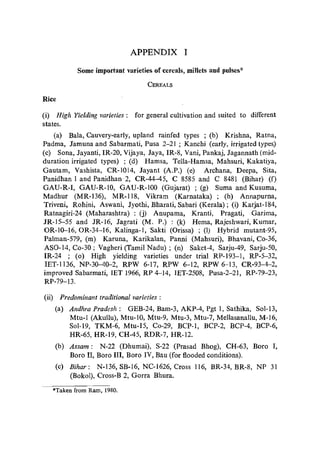This document summarizes the plant genetic resources of India. It discusses the agro-ecological regions and centers of diversity in India. It provides an appraisal of the genetic diversity found in crop plants and wild plants of agricultural importance. It describes the build-up of genetic resources through exploration and collection activities in the 1970s, both within India and abroad via germplasm exchange. It discusses future plans for exploration and collection. It addresses genetic resources conservation through both in-situ and ex-situ methods. It provides references and an appendix with additional information.
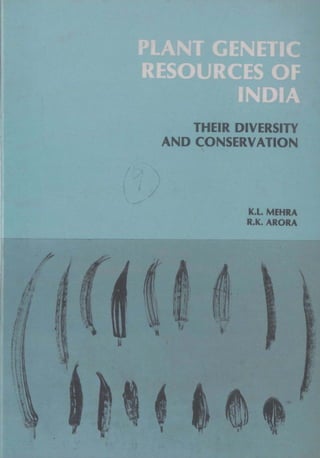


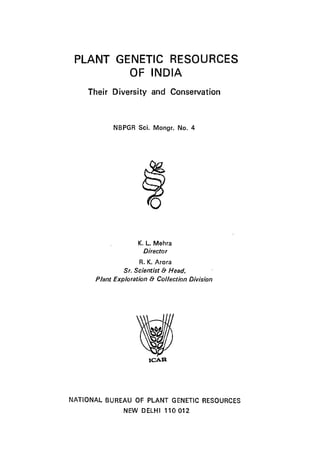
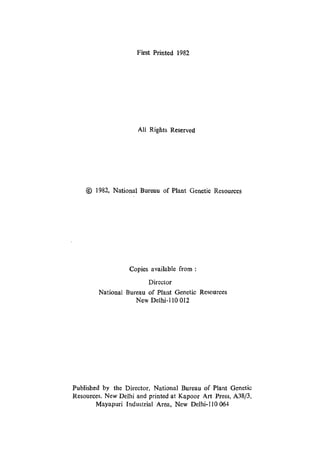
![INVOCATION
twr CfWi ~ ~ I
~~t~11
~~~~:I
lIT lJf:l, ~ CWJ:"
[~Wrf.:!~]
This universe is the creation of
the supreme power meant for
the benefit of all His creations.
Individual species must, therefore,
learn to enjoy its benefits by
forming a part of the system in
close relation with other species.
Let not anyone species encroach
upon the other's rights.
[lshopanishads]](https://image.slidesharecdn.com/plantgeneticresources-150428014242-conversion-gate02/85/Plant-genetic-resources-6-320.jpg)





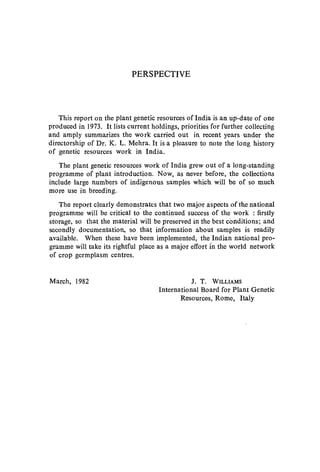

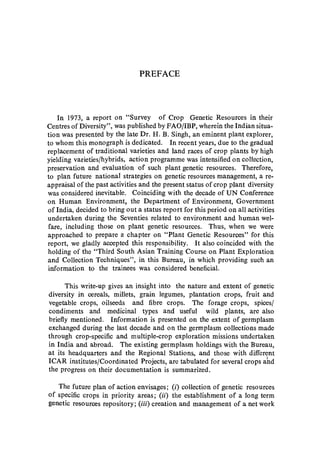





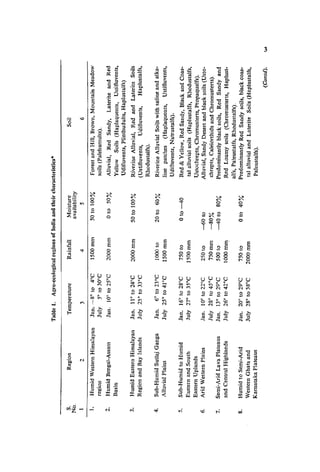
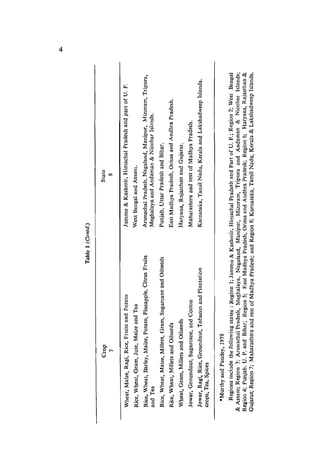


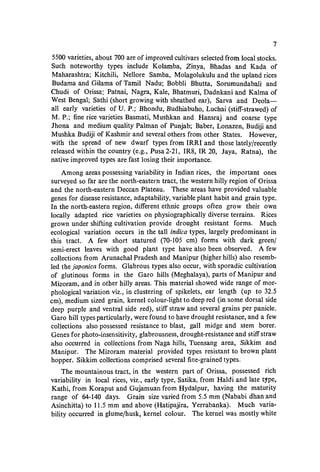




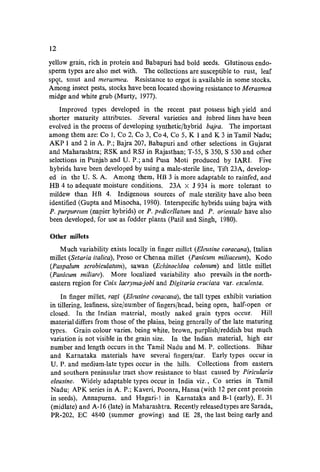

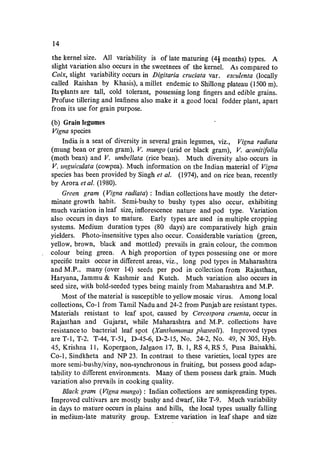






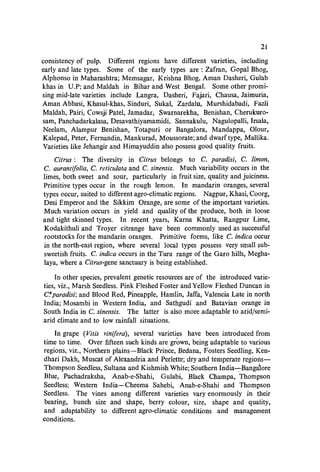



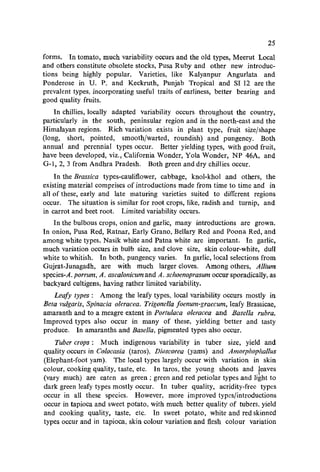
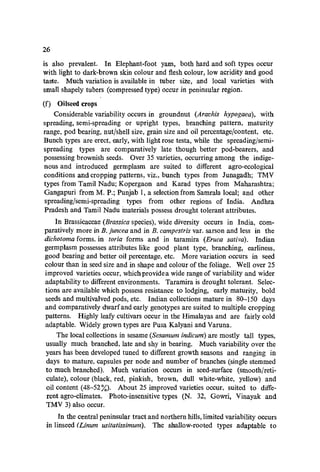

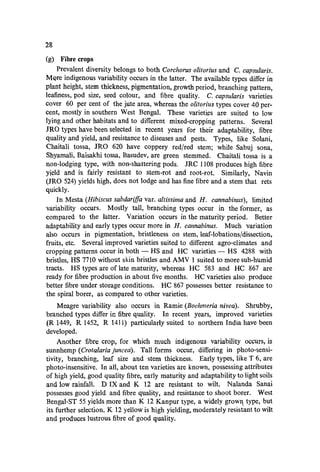

![30
bearing habit and fruit colour. The important types are known under several
local names-Balankotta, KaHu valli, Cheriakodi, Uthirankotta, Cheria
K{lmiakadan, Vania Kaniakadan, Perumkodi, Chola, Morata, Arasinamorata,
Doddiga, Tattisara--in Kerala and Karnataka. Panniyar-l is a new
hybrid variety, possessing high yield and early maturity, and is also widely
adaptable.
Indian ginger (Zingiber 0 fficinale) exihibits much diversity in forms grown
in different tracts, though introductions since distant past yield more and
are equally well adaptable viz., Rio-de-janeiro and China. Types vary in
rhizome yield and its quality. Both green and dry ginger types occur.
Several local improved cultivars (Thingpuri, Nadia, Narasapattam, Wynad,
Manantoddy, Karkal, Vengara, Ernad Mangeri and Burdwan) are known.
Another important rhizomatous spice is turmeric (Curcuma domestica), in
which the available variation pertains to size and colour of the rhizome and
in curcumin content. Several locally improved types (Patna variety ofBihar,
Lokhandi of Maharashtra with bright coloured, hard rhizome and light
coloured, soft rhizomes; ;lnd Duggirala and Tekurpeta of Andhra Pradesh
with long/short, smooth, hard fingers occur. Equally important in this tract
are varieties Kasturi Pasupa, Armoor and Chaya Pasupa.
(i) Medicinal and aromatic plants
India is endowed with rich diversity in medicinal plant resources. The
Indian Pharmacopoeia recognizes eighty-five drug plants of such kinds, of
which over 20 are commercially important. Many of them viz., Cinchona,
Isabgol, Opium poppy, Belladona, Mints, Ipecac, Foxglove, Liquorice, Celery,
Rose geranium, Jasmines and Eucalyptus, etc., were introduced. Indigenous
variability exists in Cassia angustifolia (Senna), Rauvolfia serpentina, Dios-
corea spp, Cymbopogon spp., (Lemon grass, Citronella grass, Palmarosa oil
grass), Patchouli, Vetiver, Davana (Artemisia pallens), Henna and sweet flag,
etc. (Gupta,] 980; pp. 1188-1224 in Handbook of Agriculture, revised ed.
1980,ICAR).
(j) Forage crops
Much diversity occurs in fodder types in sorghum, maize, pearl-millet
and oats, and in all of them several specific varieties occur suited to different
regions, and for different seasons. Early and late types also occur, varying
in fodder quality, yield, etc. Several local/locally improved types, like,
M.P. Chari, Haryana Cheri, Dudhia, in sorghum; Bassi, Jaunpuri in maize;
and several more in other fodder crops occur. Among legumes also, such
leafy types occur in cowpea, cluster bean, field bean, berseem, lucerne, senji,
methi. Similarly, in grass species, like, Pennisetum pedicel/alum, Panicurn
antidotale, Sorghum sudanense, hybrid napier, Cenchrus spp., Dichanthium](https://image.slidesharecdn.com/plantgeneticresources-150428014242-conversion-gate02/85/Plant-genetic-resources-47-320.jpg)


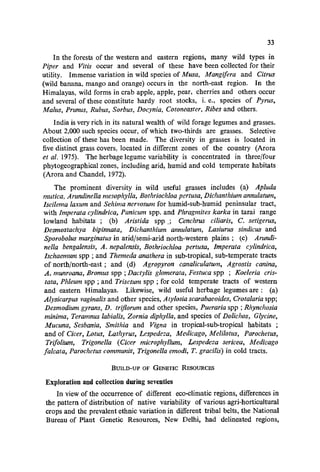




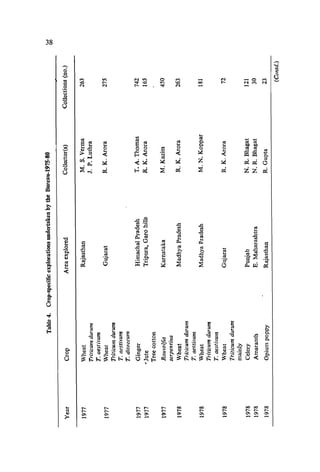



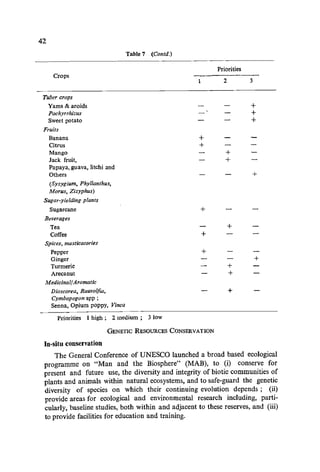


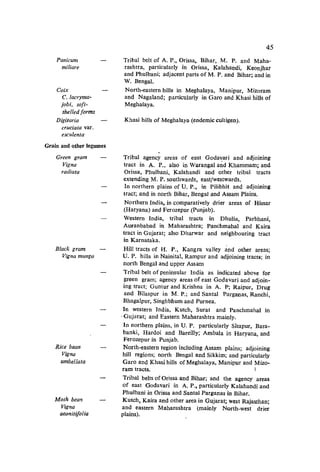
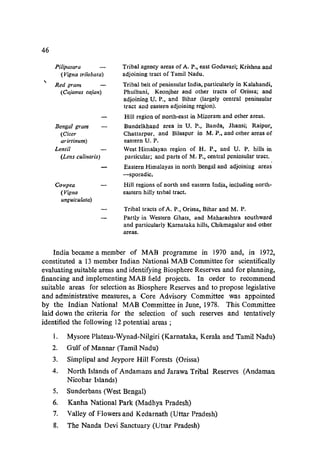
![9. Khangchendzonga National Park (Sikkim)
10. Lalichopri (Arunachal Pradesh)
II. Namdapha (Arunachal Pradesh)
12. Tura Ridge (Meghalaya).
47
Based on careful considerations, it was decided to initially select three
biologically rich areas, viz., (i) the Nilgiri Biosphere Reserve, (ii) the
Namdapha Biosphere Reserve, and (iii) the Tura Ridge (as gene sanctuary
for Citrus and other fruit plants). The project documents for these reserves
have been prepared and approved by the MAB Committee. The prepara-
tion of documents for four other proposed Biosphere Reserves is under way,
these being (i) Valley of flowers Kedarnath-Pindari; (ii) Gulf of Mannar,
(iii) the Nanda Devi Sanctuary; and (iv) the North Islands of Andamans
and Jarawa Tribal Reserve.
A draft legislation, with the collaboration of International Union for
Conservation of Nature's Commission for Environmental Policy, Law and
Administration, is under preparation by the Department of Environment of
the Government of India and is expected to be ready soon.
As compared to Biosphere Reserves, gene sancruaries are'specific pockets
of genetic diversity of crop plants and their closely related wild species,
which can be conserved in situ. One such gene sanctuary is being demar-
cated in the Garo Hills (Tura ridge) of North-eastern region for Citrus
indica (Bbag Singh, 1981). It is also envisaged to preserve here Musa,
M angifera, Citrus and other economic plants, occurring naturally as wild/
cultivated populations or as semi-protected popUlations. The genetic
diversity of economic plants and their wild relatives shall, thus, be pro-
tected and shall continue to undergo evolutionary changes in the normal
way and one could always go to these areas to explore and collect the
natural genetic diversity for use in the future plant improvement programmes
aimed at the development of plant types specifically needed in the future.
Ex-situ conservation
At present, NBPGR maintains well over 25,000 collections of various
agricultural types at its beadquarters (at Delhi) and at its Regional Stations
situated in different agro-climatic regions of the country (Table 9). Various
crop specific institutes/Stations of the Indian Council of Agricultural
Research, viz., for cotton, rice, plantation crops, tuber crops, tobacco, jute,
mango, potato, sugarcane; and other crop-based research institutes like the
Indian Agricultural Research Institute, New Delhi and several of the co-ordi-
nated projects also maintain germplasm of different agri-horticultural types.
Table ]0 gives some of the prominent institutes and the collections held by](https://image.slidesharecdn.com/plantgeneticresources-150428014242-conversion-gate02/85/Plant-genetic-resources-64-320.jpg)

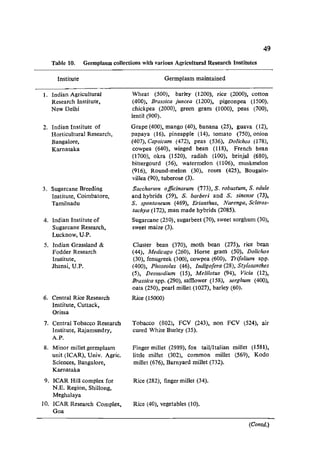



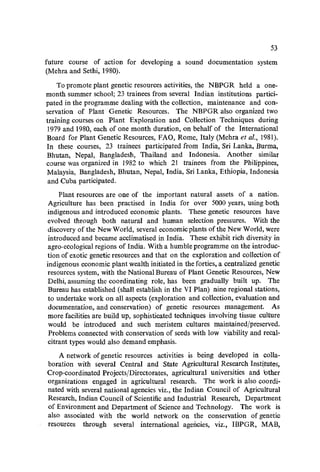

![55
20. Mehra, K. L. and Arora, R. K. 1978b. Plant genetic resources activities in
India. First IBPGR workshop on South Asian Plant Genetic Resources. Country
report. AGPE/IBPGR/PR 3/11, 23-42.
21. Mehra, K. L. and Arora, R. K. 1981. Plant genetic resources activities in
India. country report 1978-81. Second IBPGR workshop on Plant Genetic Resources
of South Asian countries, Nepal.
22. Mehra, K. L. and Sethi, K. L. (Eds.) 1980. Proceedings of first Workshop
on documentation of plant genetic resources (25-27, Nov. 1980), NBPGR Sci. Monogr.,
I, New Delhi.
23. Mehra, K. L., Arora, R. K. and Wadhi, S. R. (Eds.) 1981. Plant Explora-
tion and Collection, NBPGR, Sci. Monogr., 3 : New Delhi.
24. Murty, B. R. 1963-67. Cataloguing and classifying genetic stocks of Sorghum
(PL 480 report), IARI, New Delhi.
25. Murty, B. R. 1977. Breeding procedures in pearl millet (Pennisetum typhoides),
leAR, New Delhi.
26. Murthy, S. R. and Pandey, S. 1978. Dileneation of agro·ecological regions of
India. 11th congress, International Society of Soil Science Edminton, Canada, 19-27th
June, 1978 (cyclostyled document).
27. Patil, B. D. and Singh, A. 1980. Genetic and cytogenetic improvement of
Pennisetum and its allied species for grassland and pasture production, in Trends in
Genetical research on Pennisetums, pp. 111-122 (Eds. V. P. Gupta and J. L. Minocha),
Punjab Agric. Univ., Ludhiana.
28. Ram, M. 1980. High yielding varieties of crops. Oxford .IBH Publ. Co.,
New Delhi.
29. Shaw, F. J. F. and Khan, A. R. 1931. Studies in Indian pulses. Some
varieties of Indian gram (Cicer arietinum L.). Mem. Dept. Agri. India Bot.. 19 : 27-47.
30. Shaw, F. J. F., Khan. A. R. and Singh, H. 1933. Studies in Indian pulses.
The type of Cajanus indlcus Spr. Indian J. Agri. Sci. 3 : 1·36.
31. Singh, B. 1977. Races ofmaize in India, ICAR, New Delhi.
32. Singh, B. 198]. Establishment ojfirst gene sanctuary in India for Citrus in
Garo hills. Concept Pub). Co., New Delhi.
33. Singh, H. 1973. Far East Asia, India, in Survey ofcrop genetic resources in
their centres ofdiversity (First report, Ed. O. H. Frankel). FAOjIBP, Rome, Italy.
34. Singh, R., Joshi, B. S., Chandel, K. P. S, Pant, K. C. and Saxena, R. K.
1974. Genetic diversity in some Asiatic Phaseolus species and its conservation, in
Breeding Researches in Asia and Oceania (SABRAO Proc. Eds. Ramanujam, S. and
Iyer, R. D.). Indian J. Genet, 34A : 52-57.
35. Thuljaram Rao, J. and Krishnamurthy, T. N. 1968. Accelerating genetic
improvement in sugarcane. Indian J. Genet. 28A : 88·96. I
36. Watt, G. 1889-93. A dictionary of economic products of India, (6 Vols.).
London.
37. Zeven, A. C. and Zhukovsky, P. M. 1975. Dictionary of cultivated plants
and their centres ofdiversify, Wageningen.](https://image.slidesharecdn.com/plantgeneticresources-150428014242-conversion-gate02/85/Plant-genetic-resources-72-320.jpg)
